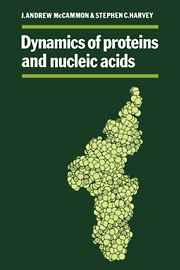Book contents
- Frontmatter
- Contents
- Preface
- 1 Introduction
- 2 Structure of proteins, nucleic acids, and their solvent surroundings
- 3 Dynamics of proteins, nucleic acids, and their solvent surroundings
- 4 Theoretical methods
- 5 Short time dynamics
- 6 Local structural transitions
- 7 Global structural changes
- 8 Dynamics of molecular associations
- 9 Recent developments and future directions
- Appendix 1 Numerical integration of the equations of motion
- Appendix 2 Detailed description of computer programs and procedures for energy minimization and molecular dynamics
- Appendix 3 Molecular dynamics at constant temperature and pressure
- References
- Index
Appendix 3 - Molecular dynamics at constant temperature and pressure
Published online by Cambridge University Press: 05 June 2012
- Frontmatter
- Contents
- Preface
- 1 Introduction
- 2 Structure of proteins, nucleic acids, and their solvent surroundings
- 3 Dynamics of proteins, nucleic acids, and their solvent surroundings
- 4 Theoretical methods
- 5 Short time dynamics
- 6 Local structural transitions
- 7 Global structural changes
- 8 Dynamics of molecular associations
- 9 Recent developments and future directions
- Appendix 1 Numerical integration of the equations of motion
- Appendix 2 Detailed description of computer programs and procedures for energy minimization and molecular dynamics
- Appendix 3 Molecular dynamics at constant temperature and pressure
- References
- Index
Summary
Molecular dynamics has an important advantage over Monte Carlo methods, in that it provides information about the time-dependence and magnitude of fluctuations in both positions and velocities, while Monte Carlo provides only positional information and gives no information on time-dependence. The original formulations of molecular dynamics had two shortcomings, however. First, simulations on fluids or solutions were carried out at constant volume, although volume fluctuations are critical to a number of phenomena. Second, the numerical integration of the equations of motion produces a trajectory in which the total energy of the system is conserved, while real systems generally exchange energy with their surroundings. A normal molecular dynamics free run corresponds to a simulation on the microcanonical ensemble, and it is often necessary to simulate the behavior of other ensembles. Methods for simulating other ensembles using Monte Carlo had been available for several years (Wood, 1968; Valleau & Whittington, 1977; Valleau & Torrie, 1977), and it was Andersen (1980) who first devised methods for molecular dynamics simulations on the other ensembles listed in table A3.1.
There are a number of situations where free molecular dynamics may be inappropriate and the methods described below are useful. For example, experiments on fluids and solutions are usually made at either fixed temperature and pressure or at fixed temperature and density, and appropriate ensembles should be used for simulations on these systems.
- Type
- Chapter
- Information
- Dynamics of Proteins and Nucleic Acids , pp. 188 - 193Publisher: Cambridge University PressPrint publication year: 1987

